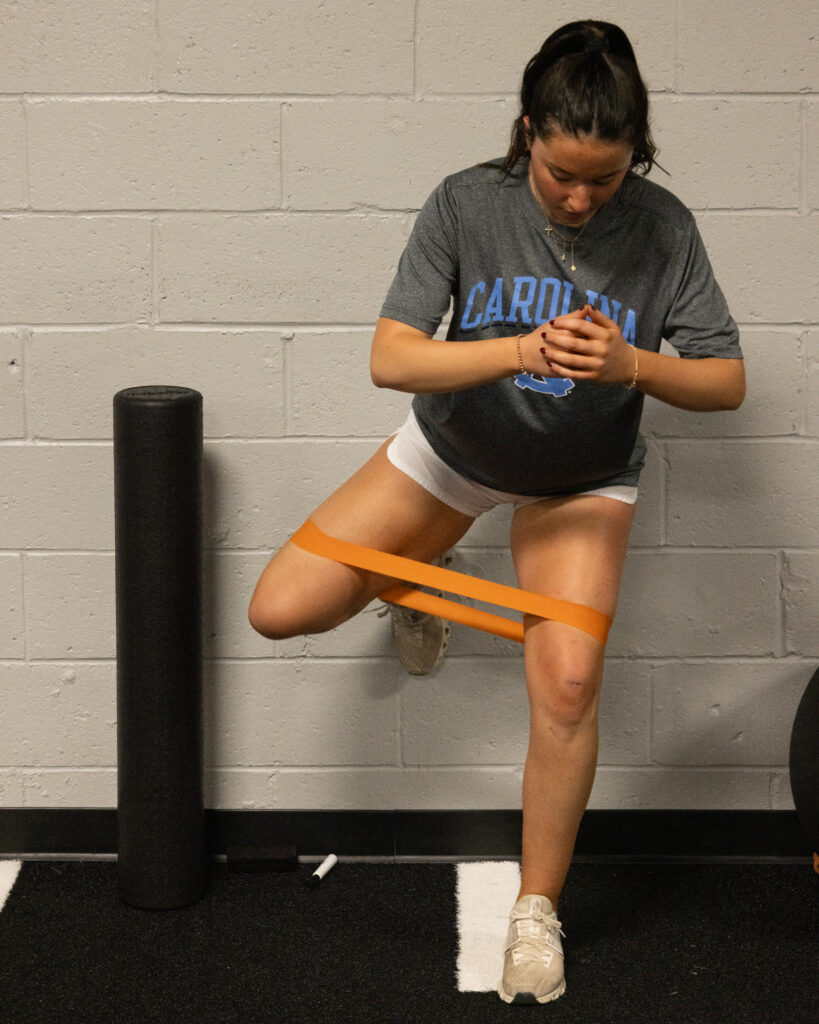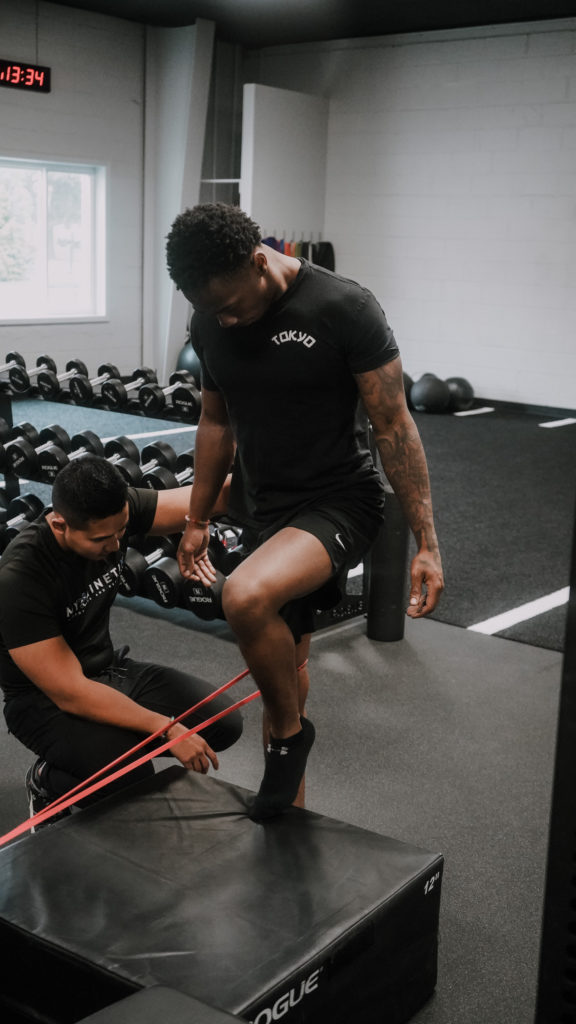- Why the phase III ACL recovery focuses on reintroducing running, agility, and plyometric activities gradually.
- How you must maintain strengthening and balance exercises to protect the knee joint and ACL repair before returning to running.
- What are the return-to-running programs that move from easy jogging to speed and agility drills, with an emphasis on proper running form and deceleration techniques.
At this stage, you’re probably itching to get back to your normal routine, and rightly so. It’s been a long 12+ weeks, but the end is in sight!
For the next two months, your ACL recovery will be focused on “the fun stuff.” Things like sport-specific movements, agility, and plyometric activities will slowly be incorporated into your rehabilitation. You’ll still be avoiding motions that cause pain. By now, you’re probably good friends with your PT and will continue to see him/her once or twice per week.

During Phase III for ACL recovery and rehabilitation, your primary goals are to strengthen and slowly reintroduce running, agility, and plyometric activities. This is done in a gradual manner and will require the expertise of your physical therapist to do so. Today’s article focuses on sharing ways in which these goals are achieved; more specifically, how to return to running after ACL surgery.
Before You Get Started
Before we discuss how to return to running after ACL surgery, it’s important to understand that you must continue your strengthening and proprioceptive activities. Exercises like straight leg raises, partial squats, leg press, hamstring curls, and calf strengthening should be done on a regular basis. Work on increasing your strength and increasing the weights as you’re able.
You should also practice various balance exercises, like variations of single-leg balance, using balance boards, foam, and the Bosu ball. You can even begin outdoor biking, but only on flat roads. Hold off on mountain biking for now.
You may be wondering why you still need to do these things if you’re getting stronger. It’s because strengthening and balance exercises add protection to the knee joint and ACL repair as you increase your activity level. Hip strengthening in particular becomes vital to prevent poor movement patterns while jumping or running. Core strength and stability of the lower body are useful to prevent rotation and maintain control while running.
So it should come as no surprise to you that you’re going to need full knee range of motion, decent strength, and no signs of swelling before you begin any return-to-running program. Your surgeon and physical therapist may have other criteria such as a passing score on specific functional assessments, especially if you’ve also had a meniscus repair. Examples of functional tests include hopping forward, laterally, and/or light jogging.
And, before you lace up your running shoes, check with your surgeon to see if you need a functional sports brace. He or she may have a preference but, if not, your physical therapist will be able to offer more insight as to which knee brace will fit your needs.
How to Return to Running After ACL Surgery
In a nutshell, here’s a general progression of a return-to-running program after ACL surgery.
- Forward and backward jogging
- Jogging in different directions
- Speed and agility drills
Typically you’ll begin with light intensity runs on soft surfaces for 3-4 days per week. It’s recommended to start for 10 minutes at least for the first two weeks before gradually increasing your time given there’s no pain or swelling in the knee joint. You’ll want to avoid drastic fluctuations in mileage as this can lead to injury. Instead, follow the 10% rule: stay below a 10% increase in mileage per week.
But returning to running after ACL surgery involves more than monitoring your time and mileage. It’s not unusual for your physical therapist to invest time working on your technique and running form during this phase. He or she will set parameters to help you avoid fatigue and encourage equal weight-bearing on both legs. You’ll also learn how to land with your midfoot, as opposed to your heel, and improve your awareness of how your body moves.
Of equal importance is your ability to decelerate, aka slow down, or accelerate, meaning to speed up. By learning how to decelerate properly, you’ll be able to safely absorb forces to transition to your next movement, whether that is another step or a jump. Both of these skills need to be mastered before moving onto speed and agility, which trains your body to move in a different direction.
While you should keep in mind that each surgeon and physical therapist will have their own return-to-running protocols, here are examples of what you should expect.
Example of a Return-to-Jogging Protocol
| Day | 1 | 2 | 3 | 4 | 5 | 6 | 7 |
| Week 1 | | Walk 5 mins & Jog 5 mins | | Walk 5 mins & Jog 5 mins | | Walk 5 mins & Jog 5 mins | |
| Week 2 | Walk 4 mins & Jog 2×5 mins | | Walk 4 mins & Jog 2×5 mins | | Walk 3 mins & Jog 3×5 mins | | Walk 3 mins & Jog 3×5 mins |
| Week 3 | | Walk 2 mins & Jog 4×5 mins | | Walk 2 mins & Jog 4×5 mins | | Walk 1 min & Jog 5×5 mins | |
Example of a Return-to-Running Protocol
| Day | 1 | 2 | 3 | 4 | 5 | 6 | 7 |
| Week 1 | | 20 mins | | 20 mins | | 20 mins | |
| Week 2 | 25 mins | | 25 mins | | 25 mins | | 30 mins |
| Week 3 | | 30 mins | | 30 mins | | 35 mins | |
| Week 4 | 35 mins | | 35 mins | | 35 mins | | 40 mins |
| Week 5 | | 40 mins | | 40 mins | | 45 mins | |
| Week 6 | 45 mins | | 45 mins | | 50 mins | | 50 mins |
| Week 7 | | 50 mins | | 55 mins | | 55 mins | |
| Week 8 | 55 mins | | 60 mins | | 60 mins | | 60 mins |
How to Return to Plyometrics After ACL Surgery
Before you embark on this type of program, be sure to have full support from your surgeon and physical therapist. A return-to-plyometrics program after ACL surgery requires skilled expertise from a physical therapist and involves several different stages over a number of weeks.
Like the return-to-running program, you’ll begin with low amplitude, low-velocity drills that work on your jumping and landing technique. During that time, you’ll focus on something called landing mechanics. This refers to your ability to bend at the hips, knees, and ankles to absorb force as you land. From there, you’ll shift your attention to jumping mechanics. Learn how to explode from the ground using your glutes, quads, and calf muscles.
Examples of low amplitude, low-velocity drills are forward and backward skipping, side shuffle, carioca, crossovers, backward jogging, shallow jump landings, and medicine ball squat catches. As you progress, your physical therapist will review proper ways to jump and land on one leg, especially when moving laterally.
Again, like the return-to-running protocol, your surgeon and physical therapist may have specific guidelines for you to follow. However, here’s a general idea of what’s to come during a return-to-plyometric program.

1. Phase 1: Forward and backward movements
- Shuttle press machine
- Box jumps
- Tuck jumps
- Forward hops
- Bounding
- Ladder drills
2. Phase 2: Lateral movements
- Side shuffle
- Carioca
- Shuttle run
- Zig-zag running
- Lateral ladder drills
3. Phase 3: Multi-Directional movements
- Box drills
- Star drills
- Jump turns
- Box jumps with changes in direction
Criteria to Progress from Phase III to Phase IV ACL Recovery and Rehabilitation
Due to the intense sport-like demands of Phase IV of ACL recovery, meeting the following milestones is essential to advance. Here’s what you’ll need:
- Clearance from your surgeon and/or physical therapist
- Completion of the return-to-running program without pain or swelling in the knee joint
- A passing score on all functional assessments, like hopping on one leg
- Quad-to-hamstring ratio greater than 70%
In addition to the physical criteria, you must demonstrate mental readiness on the Return to Sport after Injury (RSI) scale. And, although you may pass the other tests with flying colors, it’s possible that you’re not mentally ready to go back on the field yet.
It’s important to realize that you may harbor feelings of stress, anxiety, or fear about returning to the sport that caused the injury. There is a possibility that, when left unaddressed, these feelings can evolve into fear-avoidance behaviors.
Fear-avoidance behaviors describe the way in which people avoid activities that they once enjoyed out of fear of a negative outcome. Furthermore, these behaviors are associated with poor performance despite being physically capable of doing well during practice or games. On the other hand, higher levels of self-confidence and low reports of fear are associated with better outcomes from ACL surgery. The possibility of you returning to your previous level of competition is higher than those with less confidence and greater reports of fear.
From mild apprehension or severe fear-avoidance behaviors, the psychological effects of returning to play should be addressed in everyone. Therefore, don’t be surprised if your physical therapist asks you to complete the RSI scale during this phase. The doctors of physical therapy at Myokinetix value the importance of mental readiness and want to make sure you’re prepared. Combined with their experience with returning-to-running programs after ACL surgery, rest assured in knowing you’re in capable hands. Call us today at 973-585-4990 to find out more about the Myokinetix ACL Reconstruction Rehabilitation program for ACL recovery.

Thanks for pointing out the need for the support of a physical therapist and a surgeon before a return-to-plyometrics program after ACL surgery must be considered. This reminds me of a close friend who plans to find a hospital that offers knee AC reconstruction procedures before this month ends. He wants to ensure that running and physical activities will be possible again after the procedure, so your tips are helpful.